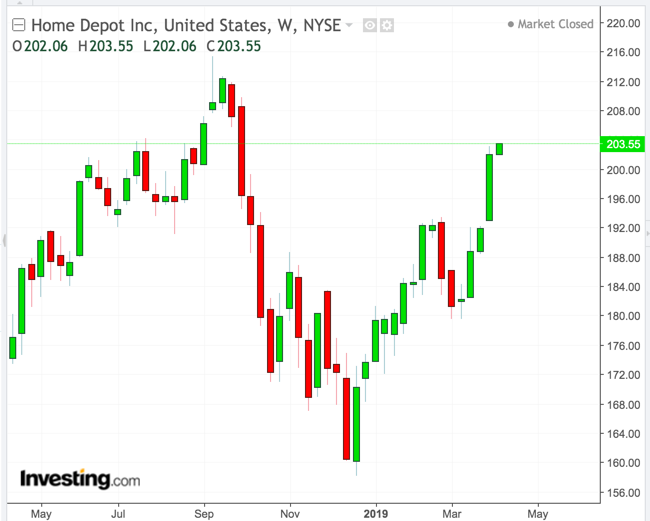It’s been a difficult 12 months for investors in Home Depot (NYSE:HD) stock. Amid slowing housing markets, rising mortgage rates, and worries about the general economic health, the largest U.S. home-improvement retailer lost its shine during the last quarter of 2018, ending a remarkable rally in its shares.
But the latest developments on the economic front, particularly in the housing market, suggest that the plunge that started in September was a short-term weakness and has run its course. Home Depot stock, which had been buoyed for years by rising housing prices in the U.S., has gained about 20% this year, to close yesterday's session at $203.55. The catalysts that prompted investors to take advantage of the retailer’s weakness were falling mortgage rates and some positive data on housing that reduced fears that the market is entering a prolonged correction.

Sales of new U.S. homes, for example, rebounded to the best pace in almost a year and exceeded estimates in February, while sales of existing homes jumped 11.8% from a month earlier. If this improvement in the macro outlook continues, we see no reason for investors to question Home Depot’s future growth. The slackness in fourth-quarter earnings was due to the seasonal factors as a harsher winter and rains kept home-improvement buyers mostly indoors.
HD’s comparable sales rose 3.2% in its fiscal fourth quarter that ended in early February, well short of the 4.5% gain analysts had been expecting. But that quarterly miss shouldn’t hide the fact that Home Depot has delivered year-over-year comparable sales growth for 30 straight quarters. Quarterly sales growth has been more than 4% for the bulk of that time, indicating that this big box retailer is pursuing an extremely successful growth strategy.
Successful Strategy to Fend Off Competition
Home Depot is one of those retailers that are best-positioned to survive an ongoing onslaught by the e-commerce disruptors, such as Amazon.com (NASDAQ:AMZN). The reason: HD management figured out early on how to thrive in this challenging environment. With 90% of Americans already living within 10 miles of a Home Depot store, rather than opening new locations, the company instead focused on upgrading its existing store base with better technology and e-commerce fulfilment capabilities.
Another important move that helped Home Depot thrive in the relatively weak housing markets of the past decade is its diversification in areas which are less dependant on the strength of the housings market. According to an analysis in the Wall Street Journal, housing starts are still less than half of what they were at their peak in early 2006, but Home Depot’s annual sales have risen by about 30% since then. “An ageing housing stock and more people deciding to stay put and make improvements on the homes they are in explain much of that discrepancy,” the Journal said in a report last year.
With this weak correlation between the two and the retailer’s success in retaining its most loyal customers, an army of contractors who get many lucrative offers to stick with Home Depot, there is a good chance that the retailer will surprise investors again with strong same-store sale growth in the first-quarter earnings report scheduled for May 21.
Home Depot sees comparable-store sales growing 5% this year - just short of 2018’s rate of 5.2 percent. We see that performance quite bullish and a good reason to buy Home Depot stock, especially when HD pays a juicy $1.36 a share quarterly dividend, following a 32% hike in the past quarter. To support its shares price, the company has also a robust $15-billion stock buyback program.
Bottom Line
An improving house market and Home Depot’s strong growth momentum should continue to support the retailer’s stock price this year. With a forward price-to-earning multiple of 21, we don’t think this stock is expensive even after its recent rebound. As well, this retailer is a reliable dividend payer. Its quarterly dividend has expanded 380% over the past decade and, with a healthy payout ratio of 42%, it has much more room to grow them. Any post-earnings weakness should be a good buying opportunity for investors who remained on the sidelines.
